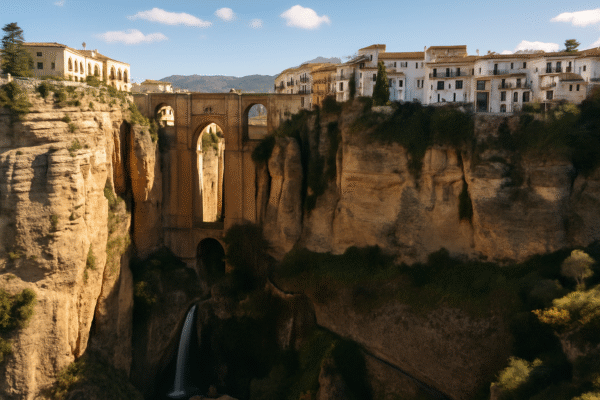Ronda, Spain: The Hidden Andalusian Town Defying Mass Tourism and Preserving Its Soul
In an era where historic towns are often overrun by crowds and commercial development, one Spanish destination is making a quiet stand. Ronda, perched dramatically above the El Tajo gorge in Andalusia, has captivated visitors not by reinventing itself for mass tourism, but by fiercely preserving its cultural roots, natural beauty, and architectural authenticity.
Located just 100 kilometers northwest of Málaga, Ronda remains a stark contrast to the Costa del Sol’s highly developed coastal resorts. It offers a deeply immersive experience — not just in what visitors see, but in what they feel — a rare feat in the modern tourism landscape.
A Town Built Over Time, Not for Tourists
Unlike many Andalusian destinations now defined by glossy hotels and busloads of tourists, Ronda has retained the soul of its past. While it’s no longer a secret, Ronda has been selective about how it engages with tourism. You won’t find international hotel chains or neon-lit souvenir stores here. Instead, you’ll be greeted by cobblestone lanes, flower-draped balconies, and terraced viewpoints where locals gather to sip wine and chat — just as they have for generations.
At the heart of this ancient town is the Puente Nuevo, or “New Bridge” — a monumental 18th-century stone arch that links the city’s old Moorish quarter with its newer Spanish expansion. Towering nearly 100 meters above the canyon floor, it’s more than an architectural marvel — it’s a symbol of Ronda’s enduring strength and timeless appeal.
History Etched in Every Stone
Ronda’s story stretches across millennia. It was once a stronghold of the Romans and later a cultural center during Moorish rule. Remnants of both civilizations still shape the town’s streetscapes and rhythms. The historic Arab Baths, dating to the 13th century and remarkably preserved, offer a glimpse into daily life under Islamic influence. Visitors can also walk through the Palacio de Mondragón, a former Moorish palace turned museum.
The influence of Castilian Spain is evident too — particularly in the imposing Plaza de Toros de Ronda, one of Spain’s oldest and most architecturally significant bullrings. While bullfighting is now rare, the ring and its adjacent museum serve as an important record of Spanish cultural history.
A Taste of Tradition: Food, Wine, and Everyday Life
What truly sets Ronda apart is the authenticity of everyday life. Local businesses — from family-owned bakeries to artisan craft stores — have not been overtaken by tourist chains. Instead, visitors are welcomed into a world where local rhythms still rule.
Cuisine here is hearty, rustic, and reflective of the land. Must-try dishes include rabo de toro (oxtail stew), migas (a traditional breadcrumb dish), and salmorejo (a thicker variation of gazpacho). These are often served in tucked-away taverns with canyon views or hidden patios brimming with jasmine and geraniums.
Wine is another key draw. The region surrounding Ronda has seen a revival in boutique vineyards and organic wine production. Wineries like Descalzos Viejos and Joaquín Fernández offer tastings with panoramic views of the Serranía de Ronda mountains — a treat for both the palate and the eyes.
Walkable, Livable, and Loved by Locals
Ronda is compact and easily explored on foot. Visitors are encouraged to slow down, wander the old town, discover artisan boutiques, and sit in sun-dappled plazas surrounded by whitewashed buildings. The town also offers a cultural pass available through the local tourism board that provides access to several key sites including the Casa del Rey Moro and the iconic Puente Nuevo Interpretation Center.
According to Spain’s official tourism portal, Ronda is increasingly being promoted not for mass tourism, but as a model of sustainable travel. It serves as a reference point for how rural and historic communities can preserve heritage while benefiting from carefully managed visitation.
Easy Access but Off the Beaten Path
Despite its remote vibe, Ronda is highly accessible. It’s a two-hour train ride from Seville and less than two hours by car from Málaga or Granada. This makes it a convenient stop for those exploring Andalusia by rail or road. Unlike coastal cities, Ronda offers altitude and authenticity, making it a compelling counterbalance for travelers seeking more than beaches.
Nearby towns such as Grazalema, Setenil de las Bodegas, and Zahara de la Sierra form part of the White Villages Route (Ruta de los Pueblos Blancos), ideal for scenic drives and cultural immersion.
Best Time to Visit
Spring (April–June) and early autumn (September–October) are ideal times to visit Ronda. The weather is warm but not stifling, trails and viewpoints are quiet, and seasonal produce is at its peak. These shoulder seasons also align with local festivals such as the Feria de Pedro Romero, a cultural event celebrating Ronda’s most famous bullfighter.
Final Thoughts: Ronda’s Lesson for the Future of Travel
Ronda is not just a destination — it’s a lesson in how travel can be both transformative and respectful. As global tourism continues to expand, the challenge lies in balancing popularity with preservation. Ronda proves it’s possible.
By resisting overdevelopment and embracing its ancient character, Ronda invites travelers to experience Spain not through curated Instagram filters but through cobbled streets, shared meals, and unfiltered human connection.
For more travel news like this, keep reading Global Travel Wire




















